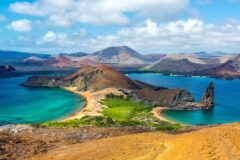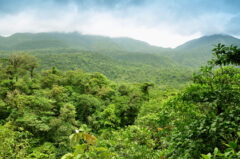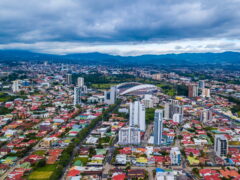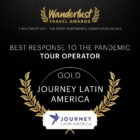Private Journeys
Self-drive Costa Rica: Coast to coast adventures
14 days from £2,400pp
(based on two people sharing & excluding flights)
Essentials
-
Tour info
-
Country info
-
What's included
Tour info
Transport
2 transfers by road and boat, and a 4WD rental car.
Accommodation
This trip combines small, friendly mid-range hotels with well-equipped rooms and comfortable but not luxurious wildlife and beach lodges.
Meals
Breakfast daily, full board days 2,3.
Guides
We carefully select our local partners, some of whom we have worked with for over 25 years. Their English-speaking guides understand the expectations of our clients very well, and are consistently singled out for praise by the latter on their return.
Summary Of Nights
14 days, 13 nights: San José 1; Tortuguero 2; Sarapiqui 1; Arenal 3; Monteverde 2; Rincón de la Vieja 2; Golfo de Papagayo 2.
Currency
The unit of currency in Costa Rica is the colón.
How To Take It
Cash machines are available in San José: taking a debit or credit card with a PIN number is the most convenient way of withdrawing money while on your trip and in many shops and restaurants you can also pay by card. However, since cards can get lost, damaged, withheld or blocked, you should not rely exclusively on a card to access funds.
We recommend that additionally you take a reasonable quantity of US dollars cash (no more than is covered by your insurance), which you can exchange into local currency in San José at the beginning of your trip, and possibly some travellers’ cheques, though these are increasingly falling out of use. (American Express cheques are the most widely accepted). Dollar bills should be in good condition, soiled or torn bills may be refused. You can exchange sterling but the rate may be unfavourable and there are fewer outlets providing this service. US dollars cash is widely accepted for payments.
Daily Spend
It is very difficult to give a guideline for essential expenses but a budget of around US$40 per day should cover the cost of meals not included in the holiday itinerary, drinks and the odd souvenir. Eat at the best restaurants and you will pay considerably more.
Tipping
Tips are welcomed and local guides often rely on their tip as a significant proportion of their income.
Most service industry workers will expect a tip of some kind and so it is useful to have spare change for hotel porters, taxi drivers and the like. It is common to leave 10 – 12% in restaurants.
Insurance And Documents
Travel insurance is essential.
Details of our recommended policy can be found on our Travel Insurance page.
From 8 June 2015 new regulations will apply concerning the paper counterpart of UK driving licences. This may affect what is required by the rental company when you collect your car.Please check https://www.gov.uk/government/news/driving-licence-changes for further details.
Additional Liability and Loss Damage Waiver (CDW without excess and inclusion of theft protection) is included as well as Personal Accident and Third Party insurance.
Airport Taxes
If you have purchased your flights through Journey Latin America, the international departure tax is usually included in the ticket.
Trip Suitability
There are no really long days of travel on the suggested routes of this trip. The routes from A to B take about 4 – 5hrs but you may well want to make a detour or stop off for a while. Roads are generally in good condition but some are unpaved and bumpy and less used routes may have potholes. Signage on major roads is good, less so on minor roads. Many people speak a little English but a smattering of Spanish will stand you in good stead.
If you have a disability that we need to be aware of, please contact us.
In the months of May to August the weather is extremely hot and humid, you might want to bear this in mind. July to November there are chances of tropical storms or hurricanes hitting the region.
Climate
The trip covers climates ranging from tropical lowland to more temperate zones in the highlands. Those travelling between May and October journeys should encounter high temperatures (around 35°C) and high humidity in the lowlands. The ‘official’ rainy (green) season is May to October.
December to April visitors will still encounter high temperatures in lowland areas, but cool evenings around Arenal and San José with temperatures falling to around 5°C. Rainfall and humidity will be lower at this time.
Clothing And Special Equipment
For day-to-day wear you should take loose-fitting, breathable clothes. Comfortable shoes are important and sandals are useful. A sun hat, sun block and sunglasses are necessary, and you should take a light fleece for cool nights and a breathable/waterproof outer layer and/or umbrella, as well as swimwear, a towel, insect repellent and a torch. A rain jacket and fleece are advisable for the cooler mountain region. If you plan to go to good restaurants or out for evening entertainment, you might bring something a bit smarter as well (although formal attire will not be required).
Please get in touch with the Journey Latin America office before departure if you have any doubts.
Sat-navs do work in Costa Rica so may want to take your own or we can arrange the hiring of one . We recommend that you always take a map as a back up!
Vaccinations
Preventative vaccinations are recommended against the following; typhoid; polio; tetanus; hepatitis A. For specific requirements you must consult your GP.
You can also find helpful information on the Masta Travel Health website.
Visas
Holders of a full British passport do not require a visa, although passports must be valid for at least 6 months after the trip begins. Anyone with a different nationality should enquire with us or check with the relevant consulate.
If flying to the US, or via the US you will need to fill in your online ESTA application.
Country info
When is the best time to visit Costa Rica?
Despite its small size, Costa Rica has a number of distinct microclimates. The best time for wildlife lovers to visit Costa Rica's Caribbean coast may be from July-August to watch nesting turtles. However, the wettest months are September to October. The rest of the country experiences a dry season Dec-April, when there is plenty of sun and temperatures are high, and a rainy season from May-Nov. However, this is variation between regions: for example, the rainy season often starts a month earlier in the south Pacific, while the northern areas, including the Guanacaste coast, are not as affected by the seasons and are generally much drier. The highlands and cloud forests have warm temperatures during the day but the high altitude means evenings are much cooler.
For more detailed information on the best time to visit Costa Rica, go to our When To Go section.
What is the official language of Costa Rica?
The official language of Costa Rica is Spanish.
What is the national currency of Costa Rica?
Colón is the national currency of Costa Rica. Notes can be withdrawn from the many ATMs using a UK credit or debit card. There is at least one in most main towns. You may have to authorise your bank first, and withdrawals may be limited to amounts lower than in the UK. US dollars cash can be exchanged in banks too. US dollars themselves are widely accepted.
What is the time difference between Costa Rica and the UK?
The time difference between the UK and Cosa Rica is GMT -5 hours.
Do I need a visa to travel to Costa Rica?
Holders of a full British passport do not require a visa, although passports must be valid for at least 6 months after the trip begins. Anyone with a different nationality should enquire with us or check with the relevant consulate.
If flying to the US, or via the US you will need to fill in your online ESTA application.
What vaccinations are recommended for visiting Costa Rica?
Please check Travel Health Pro for information on health recommendations and vaccinations for the destinations you are visiting. Please note that many Latin American countries require proof of vaccination against Yellow Fever if you have recently travelled to another country where Yellow Fever is present.
What places combine well with Costa Rica?
A visit to neighbouring Nicaragua or Panama pairs well with Costa Rica holidays. There are land crossings to both, as well as international flights.
How do I get to Costa Rica?
To get to Costa Rica there are flights from London to San José via US and European hubs.
What are the cultural and sport events in Costa Rica?
Some of the cultural events that take place in Costa Rica include:
International Arts Festival in San José in March with music, dance, and film art exhibitions. Monteverde Music Festival takes place in Monteverde between Jan - Feb.
Inspired by this trip
Our exciting range of articles on Latin America explore everything from iconic destinations and lesser-known cultural gems to delicious traditional recipes. You’ll also find exclusive travel tips, first-hand client reviews and the chance to get your personal questions answered by our travel experts.
Papagaio
Your edit for Latin American inspiration
Our exciting range of articles on Latin America explore everything from iconic destinations and lesser-known cultural gems to delicious traditional recipes. You’ll also find exclusive travel tips, first-hand client reviews and the chance to get your personal questions answered by our travel experts.
View Extraordinary Inspiration







































